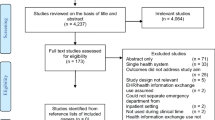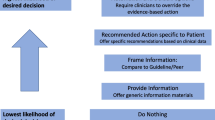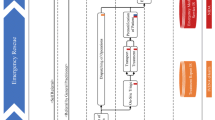Abstract
This study characterizes the information components associated with improved medical decision-making in the emergency room (ER). We looked at doctors’ decisions to use or not to use information available to them on an electronic health record (EHR) and a Health Information Exchange (HIE) network, and tested for associations between their decision and parameters related to healthcare outcomes and processes. Using information components from the EHR and HIE was significantly related to improved quality of healthcare processes. Specifically, it was associated with both a reduction in potentially avoidable admissions as well as a reduction in rapid readmissions. Overall, the three information components; namely, previous encounters, imaging, and lab results emerged as having the strongest relationship with physicians’ decisions to admit or discharge. Certain information components, however, presented an association between the diagnosis and the admission decisions (blood pressure was the most strongly associated parameter in cases of chest pain complaints and a previous surgical record for abdominal pain). These findings show that the ability to access patients’ medical history and their long term health conditions (via the EHR), including information about medications, diagnoses, recent procedures and laboratory tests is critical to forming an appropriate plan of care and eventually making more accurate admission decisions.

Similar content being viewed by others
References
Fontaine, P., Ross, S. E., Zink, T., and Schilling, L. M., Systematic review of health information exchange in primary care practices. J. Am. Board Fam. Med. 23:655–670, 2010.
Walter, S., Kostopoulos, P., Haass, A., Lesmeister, M., Grasu, M., Grunwald, I., Keller, I., Helwig, S., Becker, C., Geisel, J., Bertsch, T., Kaffiné, S., Leingärtner, A., Papanagiotou, P., Roth, C., Liu, Y., Reith, W., and Fassbender, K., Point-of-care laboratory halves door-to-therapy decision time in acute stroke. Ann. Neurol. 69:581–586, 2011.
Tierney, W. M., Improving clinical decisions and outcomes with information: a review. Int. J. Med. Inform. 62(1):1–9, 2001.
Phansalker, S., Edworthy, J., Hellier, E., Seger, D. L., Schedlbauer, A., Avery, A. J., and Bates, D. W., A review of human factors principles for the design and implementation of medication safety alerts in clinical information systems. J. Am. Med. Inform. Assoc. 17(5):493–501, 2010.
Li, J.-S., Zhang, X. G., Wang, H. Q., Wang, Y., Wang, J. M., and Shao, Q. D., The meaningful use of EMR in Chinese hospitals: A case study on curbing antibiotic abuse. J. Med. Syst. 37(2):1–10, 2013.
Faisal, A., Parveen, S., Badsha, S., Sarwar, H., and Reza, A. W., Computer assisted diagnostic system in tumor radiography. J. Med. Syst. 37(3):1–10, 2013.
Choi, C. K., Saberito, D., Tyagaraj, C., and Tyagaraj, K., Organizational performance and regulatory compliance as measured by clinical pertinence indicators before and after implementation of Anesthesia Information Management System (AIMS). J. Med. Syst. 38(1):1–6, 2014.
Devaraj, S., and Kohli, R., Information technology payoff in the health-care industry: A longitudinal study. J. Manag. Inform. Syst. 16(4):41–68, 2000.
Zhang, N. J., Seblega, B., Wan, T., Unruh, L., Agiro, A., and Miao, L., Health information technology adoption in US acute care hospitals. J. Med. Syst. 37(2):1–9, 2013.
Furukawa, M. F., Patel, V., Charles, D., Swain, M., and Mostashari, F., Hospital electronic health information exchange grew substantially in 2008–12. Health Aff. 32(8):1346–1354, 2013.
Walker, J., Pan, E., Johnston, D., Milstein, J. A., Bates, D. W., and Middleton, B., The value of health care information exchange and interoperability. Health Aff. 24:10–18, 2005.
Takian, A., Sheikh, A., and Barber, N., We are bitter, but we are better off: Case study of the implementation of an electronic health record system into a mental health hospital in England. BMC Health Serv. Res. 12:484, 2012.
Richardson, D., No relationship between emergency department activity and triage categorization. Acad. Emerg. Med. 5(2):141–145, 1998.
Dean, N. C., Suchyta, M. R., Bateman, K. A., Aronsky, D., and Hadlock, C. J., Implementation of admission decision support for community-acquired pneumonia. A pilot study. CHEST J. 117(5):1368–1377, 2000.
Garg, A. X., Adhikari, N. K., McDonald, H., Rosas-Arellano, M. P., Devereaux, P. J., Beyene, J., Sam, J., and Haynes, R. B., Effects of computerized clinical decision support systems on practitioner performance and patient outcomes. JAMA 293(10):1223–1238, 2005.
Ben-Assuli, O., Leshno, M., and Shabtai, I., Using electronic medical record systems for admission decisions in emergency departments: Examining the crowdedness effect. J. Med. Syst. 36(6):3795–3803, 2012.
Frisse, M. E., and Holmes, R. L., Estimated financial savings associated with health information exchange and ambulatory care referral. J. Biomed. Inform. 40(6):S27–S32, 2007.
Maisels, M. J., and Kring, E., Length of stay, jaundice, and hospital readmission. Pediatrics 101(6):995–998, 1998.
Ramachandran, S., Erraguntla, M., Mayer, R., and Benjamin, P., Data mining in military health systems-clinical and administrative applications. In Automation Science and Engineering, 2007. CASE 2007. IEEE International Conference on (pp. 158–163), 2007.
Axon, R. N., and Williams, M. V., Hospital readmission as an accountability measure. JAMA 305(5):504–505, 2011.
Fischer, C., Anema, H. A., and Klazinga, N. S., The validity of indicators for assessing quality of care: A review of the European literature on hospital readmission rate. Eur. J. Public Health 22(4):484–491, 2012.
Van Walraven, C., Jennings, A., and Forster, A. J., A meta–analysis of hospital 30–day avoidable readmission rates. J. Eval. Clin. Pract. 18(6):1211–1218, 2012.
Denman-Johnson, M., Bingham P and e a confidential enquiry into emergency hospital admissions on the isle of Wight, UK. Br. Med. J. 51:386–390, 1997.
Shabtai, I., Leshno, M., Blondheim, O., and Kornbluth, J., The value of information for decision-making in the healthcare environment. Stud. Health Technol. Inform. 127:91, 2007.
Cabrnoch, M., and Hasić, B., Electronic health book—a unique Czech solution for eHealth. Heal. Technol. 1:57–69, 2011.
Jarvis, B., Johnson, T., Butler, P., O’Shaughnessy, K., Fullam, F., Tran, L., and Gupta, R., Assessing the impact of electronic health records as an enabler of hospital quality and patient satisfaction. Acad. Med. J. Assoc. Am. Med. Coll. 88(10):1471–1477, 2013.
Ballard, D. W., Rauchwerger, A. S., Reed, M. E., Vinson, D. R., Mark, D. G., Offerman, S. R., Chettipally, U. K. C., Graets, I., Dayan, P., and Kuppermann, N., Emergency physicians’ knowledge and attitudes of clinical decision support in the electronic health record: A survey–based study. Acad. Emerg. Med. 20(4):352–360, 2013.
Heiro, E., and Mäntymäki, M., Managing medication information with electronic patient records – a Finnish clinicians’ perspective. Heal. Technol. 2:113–122, 2012.
Raja, A. S., Ip, I. K., Prevedello, L. M., Sodickson, A. D., Farkas, C., Zane, R. D., Hanson, R., Goldhaber, S. Z., Gill, R. R., and Khorasani, R., Effect of computerized clinical decision support on the use and yield of CT Pulmonary Angiography in the emergency department. Radiology 262:468–474, 2012.
Jones, S. S., Rudin, R. S., Perry, T., and Shekelle, P. G., Health information technology: An updated systematic review with a focus on meaningful use. Improv. Patient Care 160(1):48–55, 2014.
Ben-Assuli, O., Shabtai, I., and Leshno, M., The impact of EHR and HIE on reducing avoidable admissions: Controlling main differential diagnoses. BMC Med. Informa. Decis. Making 13:49, 2013.
Loekito, E., Bailey, J., Bellomo, R., Hart, G. K., Hegarty, C., Davey, P., Bain, C., Pilcher, D., and Schneider, H., Common laboratory tests predict imminent medical emergency team calls, intensive care unit admission or death in emergency department patients. Emerg. Med. Australas. 25(2):132–139, 2013.
Gleeson, F. V., and Gordon, I., Imaging in urinary tract infection. Arch. Dis. Child. 66(11):1282–1283, 1991.
Dick, P. T., and Feldman, W., Routine diagnostic imaging for childhood urinary tract infections: A systematic overview. J. Pediatr. 128(1):15–22, 1996.
Snodgrass, W. T., and Bush, N. C., Urinary tract infection. In Pediatric Urology. New York: Springer. 1–17, 2013.
Blumenthal, D., Stimulating the adoption of health information technology. New Engl. J. Med. 360:1477–1479, 2009.
Rokos, I. C., French, W. J., Mattu, A., Nichol, G., Farkouh, M. E., Reiffel, J., and Stone, G. W., Appropriate cardiac cath lab activation: Optimizing electrocardiogram interpretation and clinical decision-making for acute ST-elevation myocardial infarction. Am. Heart J. 160:995–1003, 2010.
Francis, S. A., Daly, C., Heydari, B., Abbasi, S., Shah, R. V., and Kwong, R. Y., Cost-effectiveness analysis for imaging techniques with a focus on cardiovascular magnetic resonance. J. Cardiov. Magn. Reson. 15(1):52–63, 2013.
Bailey, J. E., Pope, R. A., Elliott, E. C., Wan, J. Y., Waters, T. M., and Frisse, M. E., Health information exchange reduces repeated diagnostic imaging for back pain. Ann. Emerg. Med. 61(1):16–24, 2013.
AlJarullah, A., and El-Masri, S., A novel system architecture for the national integration of electronic health records: A semi-centralized approach. J. Med. Syst. 37(4):1–20, 2013.
Peleg, M., Computer-interpretable clinical guidelines: A methodological review. J. Biomed. Inform. 46(4):744–763, 2013.
Bernstein, S. L., Aronsky, D., Duseja, R., Epstein, S., Handel, D., Hwang, U., McCarthy, M., McConnell, K. J., Pines, J. M., Rathlev, N., Schafermeyer, R., Zwemer, F., Schull, M., Brent, R., and Asplin, B. R., The effect of emergency department crowding on clinically oriented outcomes. Acad. Emerg. Med. 16:1–10, 2009.
Author information
Authors and Affiliations
Corresponding author
Additional information
This article is part of the Topical Collection on Systems-Level Quality Improvement
Rights and permissions
About this article
Cite this article
Ben-Assuli, O., Shabtai, I., Leshno, M. et al. EHR in Emergency Rooms: Exploring the Effect of Key Information Components on Main Complaints. J Med Syst 38, 36 (2014). https://doi.org/10.1007/s10916-014-0036-y
Received:
Accepted:
Published:
DOI: https://doi.org/10.1007/s10916-014-0036-y




